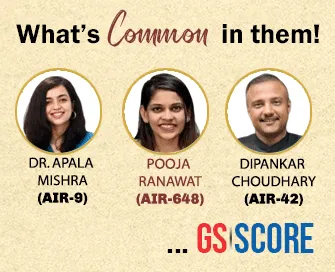

14th September 2023 (9 Topics)
Editorials
Context:
After the recent Yamuna Floods in the capital, has revoked the concern of Illegal construction work in floodplains which reduces the capacity of rivers to contain a high level of water within their banks.
The Urgent Need for Flood Management
- Frequency and Intensity of Floods: Increasing frequency and intensity of floods due to climate change pose a significant threat worldwide, as exemplified by recent disasters in Pakistan, Himachal Pradesh, and India's metropolitan areas.
- Urban vulnerability: Over 40 million hectares of land in India, nearly 12% of the total land area, is prone to floods, with cities being particularly vulnerable due to haphazard urban expansion.
- Disaster Management policy: India's current legal framework for disaster management does not adequately address the predictable risks associated with floods, highlighting the need for a change in strategy.
Shift from Flood Protection to Risk Management
- International Shift in Strategy: Countries like Germany, the U.K., and the Netherlands have transitioned from flood protection to flood risk management, emphasizing water retention and floodplain restoration over technical measures like dikes and flood defense walls.
- Limits to Rivers: Encroachments on floodplains in India, as seen in Tamil Nadu and Uttarakhand, exacerbate flooding by limiting river capacity during heavy rainfall.
- Illegal construction:Despite regulatory measures and environmental impact assessments, illegal construction and mining activities persist in these regions.
The Role of Ecosystem Preservation and Political Will
- Ecosystems as Natural Buffers: Ecosystem preservation, including wetlands, forests, lakes, and coastal areas, can serve as natural buffers against floods and other natural hazards, as demonstrated in Germany's Federal Water Act.
- Need of an integrated framework: Climate change adaptation requires an integrated framework that encompasses land use, water body preservation, coastal regulations, and environmental impact assessment laws.
- Support and Cooperation: Implementing such a framework necessitates strong political will, especially in the face of populist leaders who may resist "green" policies, putting lives, livelihoods, and infrastructure at risk.


Editorials
Context:
Kerala is facing the Nipah Virus outbreak in the State and needs an integrated approach to healthwhich can prevent zoonotic spillover.
The Nipah Virus Outbreak in Kozhikode
- Repeated Outbreaks: Kozhikode in Kerala is facing its fourth Nipah virus outbreak in five years, a zoonotic disease transmitted from fruit bats to humans.
- Deadly Nipah infection: The recent outbreak has already claimed two lives, with three more individuals testing positive, sparking fears reminiscent of the deadly 2018 outbreak when 21 out of 23 infected individuals succumbed to the virus.
- Concerns: Nipah virus still lacks a cure, and supportive care remains the sole treatment option, even within hospital settings.
Response Measures
- Immediate Response: Kerala's Health Minister has initiated extensive medical observation of hundreds of people who came into contact with the deceased and formed containment teams to manage the outbreak.
- Cross-border health approach: A central team has been dispatched to assist the State government, while neighboring states have taken precautions to prevent cross-border infections.
- Steps taken: State government has ensured the people for integrated approach.
Need for a One Health Approach
- Learning from Global Outbreaks: The recurring Nipah outbreaks underscore the role of anthropogenic activity, such as rapid agricultural expansion in fruit bat habitat zones, in zoonotic spillovers.
- Balancing approach: The One Health concept, gaining prominence through the COVID-19 pandemic, emphasizes an integrated approach to balance the health of people, animals, and the environment, recognizing their interconnectedness.
- Establishing Human-Animal Health linkage: Governments must adopt a One Health approach to prevent future outbreaks, acknowledging that human health is closely linked to the health of animals and the environment.


Editorials
Context:
The Sixteenth Finance commission constituted recently, has to take a stand and must re-examine revenue allocation among states in light of post-GST changes.
The Transformation of India's Taxation System
- Introduction to GST: The 122nd Constitutional Amendment of 2016 brought about a significant change in India's fiscal landscape, introducing the Goods and Services Tax (GST) regime in 2017.
- Shifting Dynamics of federalism: GST shifted India from a production-based taxation system to a consumption-based one, reshaping the dynamics of federalism by allowing both the Union and states to collect indirect taxes.
- Increasing tax burden on states: The destination principle for cross-border trade ensured that consuming states benefited, in contrast to the earlier system where rich manufacturing states exported tax burdens to consuming states.
Challenges and the Need for Reforms
- Discrepancies in Fiscal Transfer System: Despite the shift to a consumption-based tax system, India's fiscal transfer system remains based on the principles of the previous origin-based tax era, leading to disconnects between operational tax regimes and sharing criteria.
- Present re-examination: The upcoming 16th Finance Commission should be tasked with re-examining tax-sharing principles in light of the new fiscal federalism landscape.
- Issue of IGST: Reforms should start with redefining the divisible pool, including unsettled IGST with input tax credit, and addressing cash flow issues for state governments.
Redesigning Tax Sharing and Fiscal Monitoring
- Addressing Horizontal Distribution: Criteria for the distribution of the divisible pool among states, particularly for equalizing grants, need to be reimagined to align with the consumption-based tax system.
- Compensation grants:The fiscal year after the GST compensation grants, which extend to March 31, 2026, will be the base year for the 16th Finance Commission's award from 2027 to 2032.
- Approach based reforms: The need, viability, and desirability of the compensation scheme should be reviewed, considering the revenue performance of GST during the past six years.


Editorials
Context:
Recently, India has initiated the Global Biofuel alliance during G20 Summit 2023, which raises question on India’s potential for biofuel sustainability. Any strategy needs to be carefully examined in the context of the larger ecosystem to avoid negative consequences.
Biofuels vs. Electric Vehicles
- Changing Dynamics: While electric vehicles (EVs) have gained popularity, it's clear that transitioning to EVs is not without challenges, such as the need to replace existing internal combustion engine (ICE) vehicles and infrastructure, which is capital-intensive.
- Burden of importing batteries for EVs: Additionally, the import of batteries and critical minerals for EVs raises environmental concerns related to mining and supply chain issues.
- Focus on Indigenous: Biofuels offer an alternative with minimal modifications required for existing ICE engines and infrastructure, providing import independence.
Biofuel Challenges in India
- India's Biofuel Scenario: India primarily focuses on first-generation (1G) ethanol sourced from food crops, targeting 20% ethanol blending with petrol by 2025-26.
- Burdening Agriculture: However, this strategy relies on diverting surplus food crops to energy production, which may not be sustainable given stagnating crop yields, groundwater depletion, and the need for food security.
- Increasing Greenhouse gas emission: The agriculture sector, responsible for motor fuel production, also contributes significantly to greenhouse gas emissions, creating a complex balance between emissions reduction and food production.
Need for Sustainable Biofuels
- Promoting Sustainable Biomass: Sustainable biofuels, produced from crop residues and waste with low water and greenhouse gas footprints, offer a viable solution.
- Recent Intervention: The Global Biofuels Alliance formed at the G-20 Summit aims to strengthen sustainable biofuel development and ethanol adoption.
- Way forward: Prioritizing biomass for sectors with limited low-carbon alternatives, such as long-haul aviation and road freight, can play a crucial role in achieving net-zero emissions by 2050.




